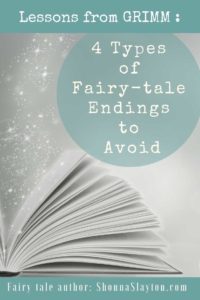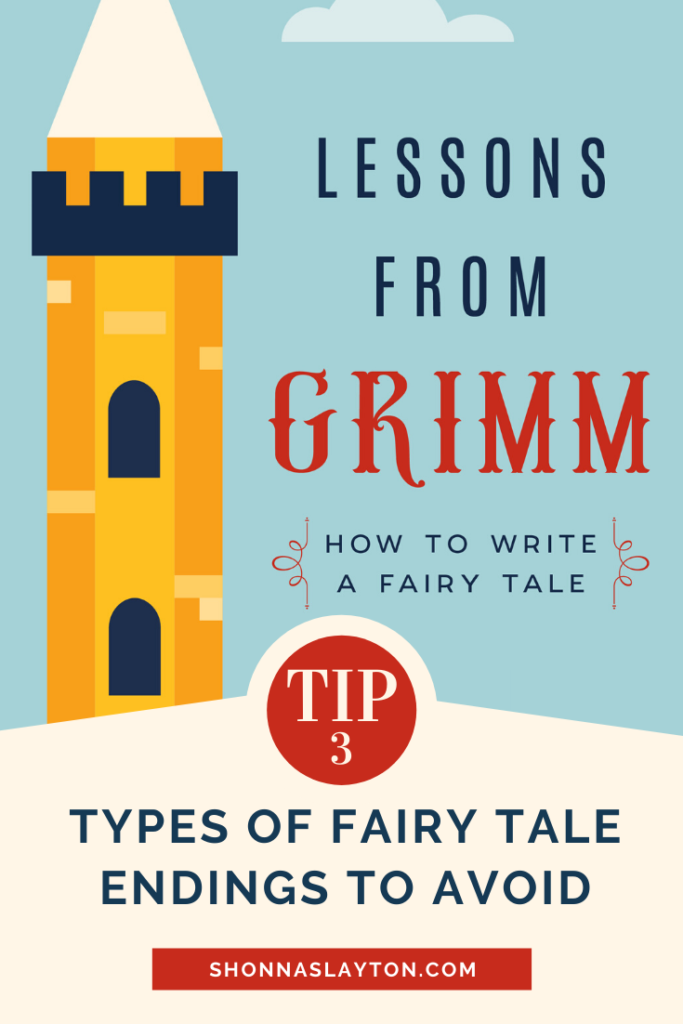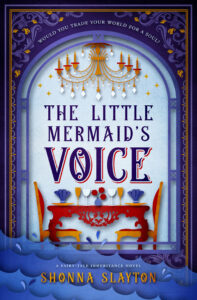Normally, we think of HEAs (Happily Ever Afters) when we talk about fairy-tale endings. But as we read through all of Grimm’s Fairy tales this year, I’m noticing several patterns beginning to show up in the endings.
A lot of the story endings feel tacked-on, rushed, hero-flipped, or seemingly a mashup of two stories. These fairy tales could have ended earlier and been better for it.
1. Tacked-on Ending
Tacked-on endings are endings that feel abrupt or unrelated to the narrative that came before it.
Last week we read Faithful John, which was a fairly fleshed-out tale compared to other Grimm’s stories, but the ending would have been so much better if it left off with faithful John as a statue, having bravely kept his promise to his King to protect his son, even if it cost him his life.
The current ending goes on to have that son kill his twins and spread their blood to save John, only to have everyone magically alive again at the end.
Wow. I could have done without it this short, tacked-on ending.
Why in the world would this be included? John sacrificed himself to save his king’s son, a noble endeavor, but there wasn’t anything noble in the king’s son sacrificing his kids with no hope of the loss being temporary and redeemed…and for the twins mother to agree that her husband had made a good choice before even seeing the results!?
Just, no.
End the fairy tale with John being faithful to the end. A tragic, bittersweet ending that would resonate with the son, seeing the statue every day as a reminder for him to become a better king.
2. Rushed Ending
Rapunzel’s ending feels rushed.
The beginning of the story has a leisurely pace in comparison to the end, as it sets up the main part of the story:
The pregnant mother is craving some of that delicious looking rapunzel (rampion–a vegetable from the turnip family; you can eat the roots, and the leaves can be used in salads) in her neighbor’s garden so much so that her husband steals some for her. After she has a taste, the cravings get worse! And when her husband steals more, he gets caught by the witch who owns the garden.
Then, by the end of the story, we’re almost getting a list of events. This happens and then this happens, and then this. It reads like the writer’s notes I leave myself so that I can get the thoughts out of my head before I forget them.
When writing your ending, give your reader the full dénouement. Especially if they’ve enjoyed the story, they’ll want to linger a bit. They may even be reading more slowly because they know the ending is coming, and they’re not ready to leave the story world you’ve created.
3. Hero-flipped Ending
I just made that category up, but I don’t know what else to call it. It’s when we’ve been reading about one character or set of characters for the whole story and then suddenly at the end, someone else becomes the hero. This type of ending is deeply unsatisfying.
The very first Grimm’s Fairy Tale is The Frog King, or Iron Henry. Even the title is confused about who this story is ultimately about!
In this story, a spoiled princess drops her golden ball down a well. A cursed prince in the form of a frog agrees to retrieve the ball if the princess will take him home and let him live with her. She agrees, gets the ball, then promptly leaves the frog at the well and goes home.
In this fairy-tale ending, the prince becomes a man again, marries the princess, and then is reunited with his faithful servant, who is so overjoyed to have the prince back that the bands of iron on his heart burst.
Hold on a second.
Why are we suddenly talking about this servant, who is sounding more heroic than either of our flawed main characters? Where was this servant the whole time? Why aren’t we told about him in the beginning? Or the middle? Or even close to the end?
If the servant is going to show up in the ninth hour, we should have had a hint about him earlier on in the story. Not that there are strict rules in writing (if it works for the story, it works) but generally, writers should introduce all their major character before the midpoint. Even if they don’t physically walk into a scene until later, readers should at least know about them.
Maybe this faithful servant had been scouting potential princesses for his master, and had specifically placed the frog in this well in the hopes that the princess would find him. Then his appearance at the end would make a lot more sense.
Even so. The main character, the hero we’ve been routing for all along, should, in the end save the day.
4. Mashed-up Ending

Sometimes a fairy tale seems like it’s two stories that got smashed together.
Little Brother and Little Sister could easily have been two separate tales: one in which a brother is turned into a fawn, and the other in which a lowborn queen is supplanted by her stepsister.
In the first part of the story, there is a natural ending when the king finds the sister hiding in the woods by following the fawn with the golden garter. The king proposes marriage and takes both the sister and her brother-fawn to the castle to live happily ever after. That’s not the end of the story, but it should be (!)
We then enter a part 2 where the evil stepmother finds out about the children’s happiness and cooks up a plan to make her daughter look like the now-queen and take her place.
Wait. What daughter?
In the Little Brother and Little Sister, we learn early on that the orphaned children are running away from their stepmother, and that spot in the story would have been a great time to tell us about the stepsister, who makes a surprising entrance at the end of the story. Was she a vindictive girl, fully on board with her mother’s treatment of these orphans? Or was she a pawn, unable to break away from her mother?
There isn’t much of a through-line from the first part of the story to the second. In the first part the stepmother appears to be trying to destroy the children’s happiness out of spite because they ran away from her.
But then in the second part she becomes proactive in her quest to raise up her own child. If her motivations had been consistent throughout, the mashed-up ending would have felt like it belonged better than it does now.
5. Satisfying Endings
Satisfying endings tie up all the story threads that have come before. We often get our first hints of the ending right in the beginning of the story, so we get a nice bookend effect, tying the story together.
Of the Grimm fairy tales we’ve read so far (three weeks into our #GRIMMread2019 challenge), The Twelve Brothers comes close to a satisfying ending….if we were permitted to delete the tacked-on final two sentences about the evil mother being put into a barrel filled with boiling oil and snakes!
In The Twelve Brothers, we have a bookended beginning and ending.
Beginning: The story begins with the twelve boys and the impending arrival of the thirteenth child, the sister, who will cause the death of the brothers.
Ending: The brothers are causing the death of the sister as she is being burned at the stake for protecting them. And in the end the brothers save the sister as the sister had saved them.
Ah, see? All the threads tie up in the end. It all goes together, and we can close the book, knowing they are all living happily ever after.
(updated note: while reading Tamara Ruth’s blog post in the Week 3 linky blog hop I was reminded that a big thread was left untied…we never find out what happened to the children’s parents! It was like they no longer existed after the daughter left to find her brothers.)
I understand that the Grimm brothers were trying to preserve the oral tales as they were told, but they did make changes over the years to the stories, and I wish they’d edited some of these endings to make them more satisfying.





I have been feeling the oddness of the Grimm tales, especially the endings, too. Thanks for posting.
Even though they are odd, I’m starting to develop a certain affection for them.
Shonna,
Take a few seconds and read The Golden Key. It’s short. Check out that ending because, dear me, it totally leaves you hanging. I’m wondering if there’s another tale that finishes it????